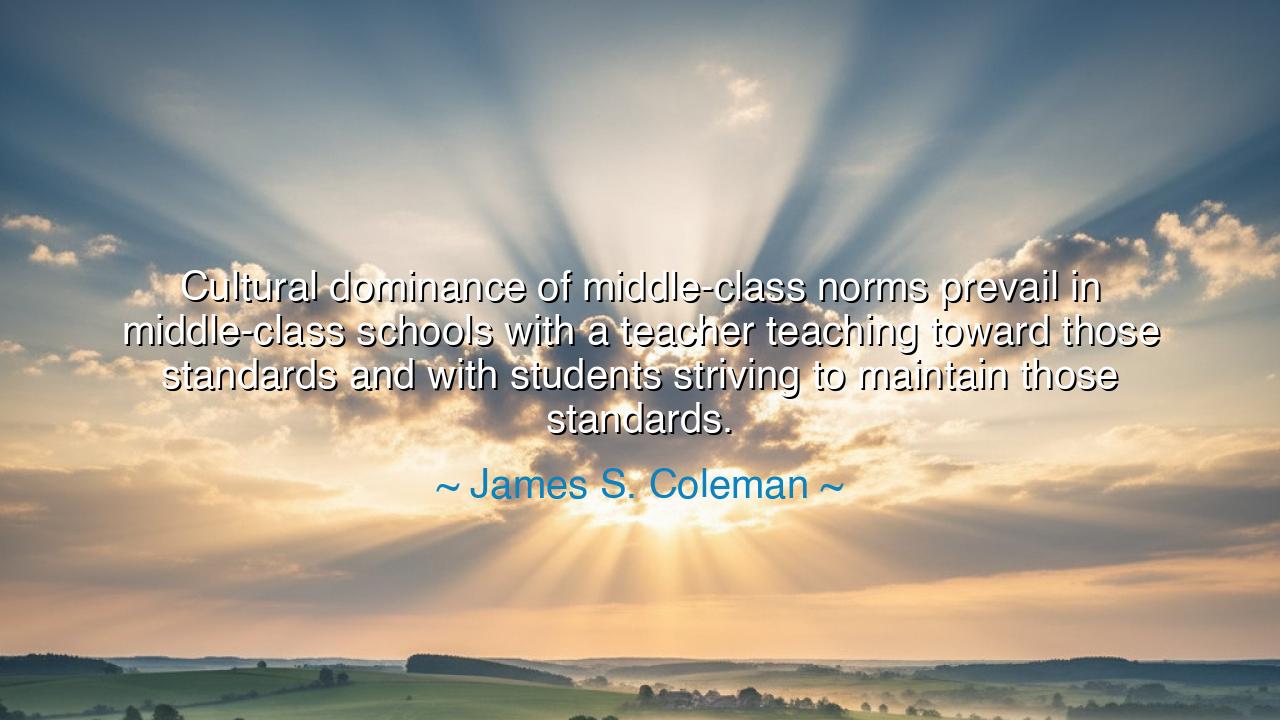
Cultural dominance of middle-class norms prevail in middle-class
Cultural dominance of middle-class norms prevail in middle-class schools with a teacher teaching toward those standards and with students striving to maintain those standards.






James S. Coleman, the great sociologist of education, once observed with clarity: “Cultural dominance of middle-class norms prevail in middle-class schools with a teacher teaching toward those standards and with students striving to maintain those standards.” In this single reflection, he unveiled the hidden power of culture within education—the way schools do not merely transmit knowledge, but also enforce the values, habits, and expectations of the class that controls them. What seems natural and neutral in schooling is in truth the invisible hand of culture, shaping the young into the mold of society’s middle ground.
The meaning of this quote lies in the recognition that schools are not only houses of learning, but also temples of conformity. When Coleman speaks of middle-class norms, he refers to punctuality, obedience, ambition, competition, and the pursuit of measured success. These norms, though not universal, dominate the classroom because the teacher teaches toward them, often unconsciously, and the students, desiring approval and advancement, strive to align themselves accordingly. Thus the school becomes less a neutral ground of pure knowledge, and more a field where the values of one class are planted deep into the soil of the next generation.
The origin of this insight lies in Coleman’s groundbreaking research, most famously the Coleman Report of 1966, which examined equality of educational opportunity in the United States. He saw clearly that the outcomes of education were shaped not only by resources, but by cultural expectations and the social environments of schools. It was not enough to have books and desks; the unseen weight of cultural dominance determined whether students thrived or faltered. Those aligned with the middle-class culture found affirmation, while those from different traditions often found alienation.
History gives us many echoes of this truth. Consider the story of Native American children sent to boarding schools in the 19th and early 20th centuries in the United States. These schools did not simply teach arithmetic or language; they enforced the cultural dominance of Euro-American norms. Children were stripped of their languages, dress, and traditions in order to conform to the so-called "standards" of the dominant culture. The cost was not only personal sorrow, but the near erasure of ancestral knowledge. This tragic example reveals Coleman’s truth on a grand scale: education is never neutral, it always transmits the values of those who control it.
Yet Coleman’s words are not merely critical; they are a call to awareness. If we recognize that teachers shape culture as well as knowledge, we see that they hold a responsibility not only to uphold certain standards but also to question them. Should education serve only the middle-class norms, or should it embrace the diverse cultural wealth of all students? Should children be trained only to conform, or should they be guided toward creativity, justice, and wisdom? These are the questions hidden beneath Coleman’s observation.
The lesson for us is clear: we must look deeper into what our schools are truly teaching. Not only the content of textbooks, but the values embedded in discipline, reward, and expectation. Do we teach children that worth lies only in grades, or do we teach them the worth of character? Do we reward only those who conform, or do we honor the voices of those who bring new perspectives? The dominance of culture is powerful, but it need not be a prison—it can also be expanded into inclusiveness, if we choose.
Practically, this means cultivating classrooms that respect diverse backgrounds. Teachers can learn from their students as well as teach them, incorporating cultural traditions, languages, and values into the fabric of learning. Parents and communities must also guard against the silent erasure of difference by demanding schools that honor not only achievement, but also identity. And each of us, in our daily encounters, can act as educators by honoring the dignity of others’ cultures.
So let Coleman’s words endure as a reminder: schools are not only mirrors of society, but forges of its future. If the cultural dominance of one class prevails unchecked, then the voices of many will be silenced. But if we awaken to this truth, if we use education as a tool not only for conformity but for liberation, then the classroom becomes not a cage but a crucible—where the many colors of human culture burn together to forge a stronger, freer, and wiser humanity.






AAdministratorAdministrator
Welcome, honored guests. Please leave a comment, we will respond soon